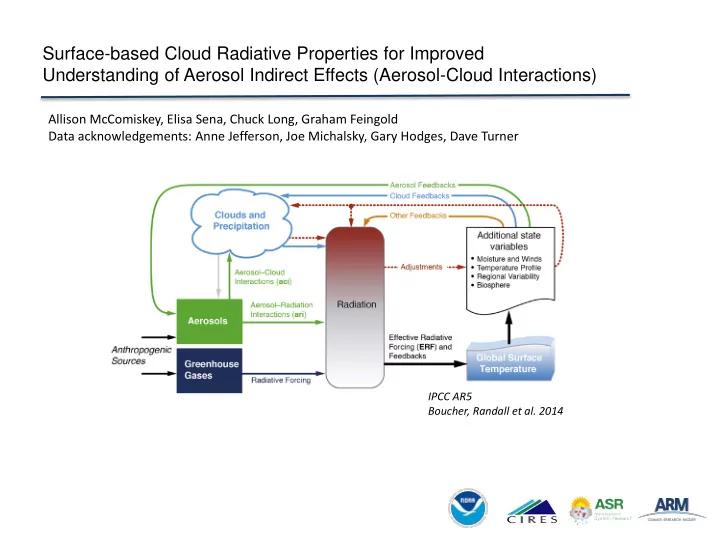

Surface-based Cloud Radiative Properties for Improved Understanding of Aerosol Indirect Effects (Aerosol-Cloud Interactions) Allison McComiskey, Elisa Sena, Chuck Long, Graham Feingold Data acknowledgements: Anne Jefferson, Joe Michalsky, Gary Hodges, Dave Turner IPCC AR5 Boucher, Randall et al. 2014
Forcers and Feedbacks in the Climate System IPCC AR5 Boucher, Randall et al. 2014 “We propose that the difficulty in untangling relationships among the aerosol, clouds and precipitation reflects the inadequacy of existing tools and methodologies and a failure to account for processes that buffer cloud and precipitation responses to aerosol perturbations.” Stevens and Feingold, 2009, Nature
Critical Properties and Processes of the Aerosol-Cloud System cloud radiative Ghan et al. in prep forcing cloud albedo entrainment cloud optical cloud depth fraction effective radius droplet number precipitation super- cloud liquid saturation heating rate water profiles ‘bottom- updraft velocity up’ latent/sensible cloud heat fluxes surface radiative condensation heating/cooling nuclei aerosol emissions “Uncertainty can be reduced if observations can be used to constrain each term…”
First measurements of the Twomey effect using ground-based remote sensors Southern Great Plains Feingold et al. 2003 GRL
Closure Experiments: Optical depth and microphysical properties model input N d N d = f(w, N a ) aerosol, vertical velocity, liquid water path model output w cloud optical depth, effective radius, drop number N a L g m -2 optical depth modeled N d cm -3 modeled r e μm modeled r e μm observed N d cm -3 observed optical depth observed
Reconciling ‘bottom-up’ measurements with model radiative forcing Aerosol-Cloud Interactions Aerosol Indirect Effects McComiskey et al. 2012, ACP McComiskey et al. 2008, GRL
Critical Properties and Processes of the Aerosol-Cloud System cloud radiative Ghan et al. in prep forcing cloud albedo entrainment cloud optical cloud depth fraction effective radius ‘top-down’ droplet number precipitation super- cloud liquid saturation heating rate water profiles ‘bottom- updraft up’ velocity latent/sensible cloud heat fluxes surface radiative condensation heating/cooling nuclei aerosol emissions Uncertainty can be reduced if observations can be used to constrain each term
Cloud Radiative Properties 1997-2008 Southern Great Plains rCRF CRF continuous, high resolution (1- min) broadband surface irradiance observations: • quality controlled (Long and Shi 2008) • clear-sky estimated • surface, cloud properties retrieved (Long et al. 2000, 2006) • simultaneous retrieval of cloud fraction, cloud albedo, and relative cloud radiative forcing ( rCRF ) • assumption of single layer cloud • error estimates used to scale cloud albedo for neglect of cloud absorption (Liu et al. 2010, Xie and Liu 2013) Both long-term and detailed measurements required for system understanding can only be gained from continuous, ground-based measurements
Relative contributions of cloud fraction and cloud albedo to cloud radiative forcing Control by Semi-Direct Effect/ meteorology Albrecht Effect Twomey Effect Control by aerosol Quantifying relative contributions in different regimes indicates the potential for various aerosol indirect effects and differentiation of meteorological and aerosol drivers
Distribution of correlations: rCRF x Aerosol Index (surface) what do the highest positive and negative correlations reveal?
Highest positive and negative correlations: rCRF x Aerosol Index (surface) r < -0.8 r > 0.8 cloud fraction cloud albedo aerosol index surface aerosol index surface cloud fractions and cloud albedo are reduced when aerosol concentrations increases
Normalized difference index: liquid water path cloud optical depth effective radius drop number aerosol McComiskey et al. 2009, JGR a difference index is used to normalize for meteorological driven variability and to isolate variability in cloud microphysics
Normalized difference index rCRF cloud fraction cloud albedo cloud microphysics index shows some relationship to aerosol optical depth
Concluding Remarks ➤ the relative roles of aerosol and meteorological variables on cloud radiative forcing, cloud albedo, and cloud fraction can be discerned using surface radiometry alone ➤ for this case aerosol optical depth better correlates with cloud properties than aerosol properties at the surface ➤ understanding the relative contributions of cloud fraction and cloud albedo to cloud radiative forcing can serve as an indication of specific aerosol-cloud processes ➤ the dominant control between cloud albedo and cloud fraction on cloud radiative forcing depends on cloud fraction ➤ a normalized cloud optical depth index (by liquid water path) can be used as a proxy for variability in cloud microphysical properties ➤ in the US Southern Great Plains: ➤ cloud radiative forcing and liquid water are positively related (more negative CRF/more cooling) ➤ cloud radiative forcing and aerosol are negatively related (less negative CRF/less cooling)
Oreopolous and Platnick 2008, JGR
Future directions ➤ test the chain of microphysical and dynamical processes in aerosol-cloud GMD Observatories interactions within the constraint of aerosol indirect effects quantified by cloud radiative properties ➤ examine relationships in other locations/regimes where positive and/or stronger relationships between Surfrad sites aerosol and cloud radiative forcing are expected ➤ compare to similar analyses from model output at a range of scales DOE ARM deployment locations
IPCC AR4 cloud albedo cloud fraction cloud albedo + cloud fraction + + = RF Reductionist Approach
IPCC AR4 Reductionist Approach IPCC AR5 Integrative Approach
Control of cloud radiative forcing: liquid water path and aerosol rCRF cloud fraction cloud albedo
Recommend
More recommend